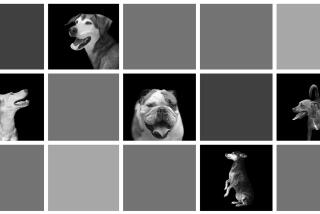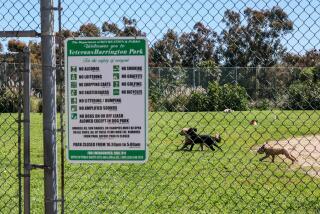A DOG’S LIFE : When You Reside in the City, Keeping a Canine Means Living on a Short Leash
My friend George is a composer of no small talent, well read in philosophy and the arts, a toiler in the hip new world of inter-media. He plays in a million bands, mostly one-off things, though the one he led a decade ago is still revered in certain circles, and he has written computer-based music for both avant-garde dance performances and for Calvin Klein. He is the man you want on your side in a coffeehouse argument about Bunuel. But mostly George is an owner of dogs, a dog owner nearly to the point of homelessness.
His first dog, Abelard, showed up a couple of years ago, a smart, shaggy thing George rescued from the friend of a friend. Gummo came soon afterward, a manic terrier with the speed and leaping ability to rocket into your solar plexus from a standing start. Gummo and Abelard at once developed a sort of insidious teamwork, a talent for cute obnoxiousness. It is amazing how quickly George’s dogs can reduce a Sunday newspaper into an ankle-high blizzard of lint.
George doted on his dogs, cooking them garlic-laden dinners and schlepping them to the dog park, cutting short appointments in order to play with them more. He became a regular reader of all-pooch classified-ad tabloids that read like lonely-hearts publications for dogs. He has not had an answering-machine message in months that hasn’t featured barks or snarls, and I believe if you were to show him a fluffy cloud or an ink blot, George would see only sharp-snouted Gummo.
But it’s not easy to keep noisy dogs in the city, not if you don’t have the money for a proper yard anyway. Urban dog owners, denied access to cool, rent-controlled apartments and sweetheart roommate deals, compose the basic rental market for remote hillside shacks leased complete with rusting Buicks. Hordes of apartment owners refuse to rent to you, letters are sent to the health department, nuisance complaints are phoned in to the cops. People why try to be responsible dog owners end up being controlled by their pets.
George was able to keep the first place for a few years, a little Hollywood bungalow, mostly because his nearest neighbor was hard of hearing and a good-natured fellow, but an unfriendly guy moved in next door and George’s luck ran out.
George tried all the usual inducements to get his dogs to stop barking, and a few of the weirder ones as well: homeopathic flower oils designed to get Gummo and Abelard in touch with their inner puppies, tinctures of camomile, even more elaborate home-cooked dinners. Someone suggested barbaric vocal chord surgery: out of the question. A veterinarian recommended a special collar that would give Gummo a mild shock when he barked, but George thought it was cruel and the pain potentially more confusing than instructive.
The dogs do seem to calm down a bit when George leaves them alone with MTV on, which may answer the question of who the target audience for Counting Crows videos might be, but doesn’t really appease the neighbors. George was set to vacate the first bungalow, but after a lengthy search was suddenly dis-invited by the owner of the potential second home.
He was accepted at a third, but the neighborhood’s idea of a dog seemed to be more that of an animate stuffed animal than an actual biological entity--there were even petitions circulated by anti-canine vigilantes--and George was kicked out of the bungalow before he had a chance to unpack his boxes of stuff. The dogs are temporarily living at a friend’s house and George with his girlfriend, but it feels like a sad Simon Legree tale, a tragically broken home.
More to Read
Sign up for Essential California
The most important California stories and recommendations in your inbox every morning.
You may occasionally receive promotional content from the Los Angeles Times.











